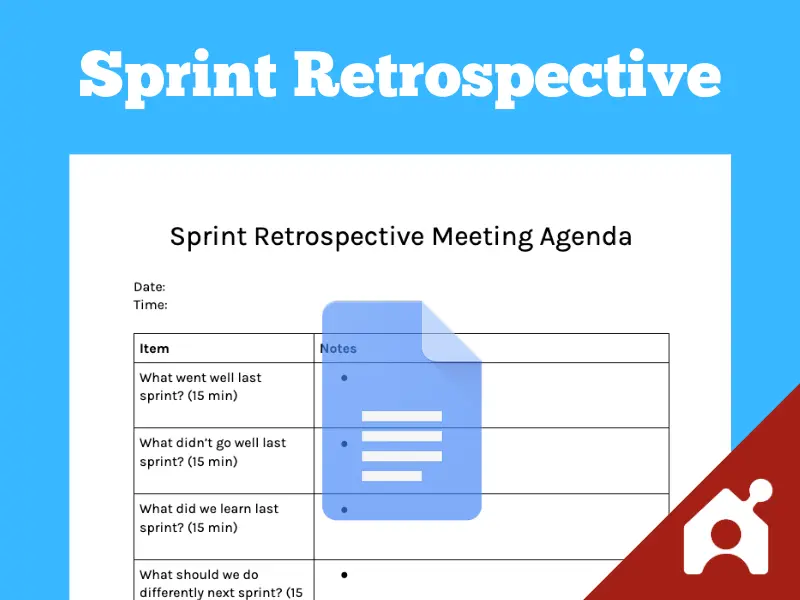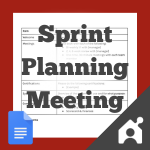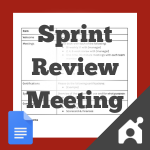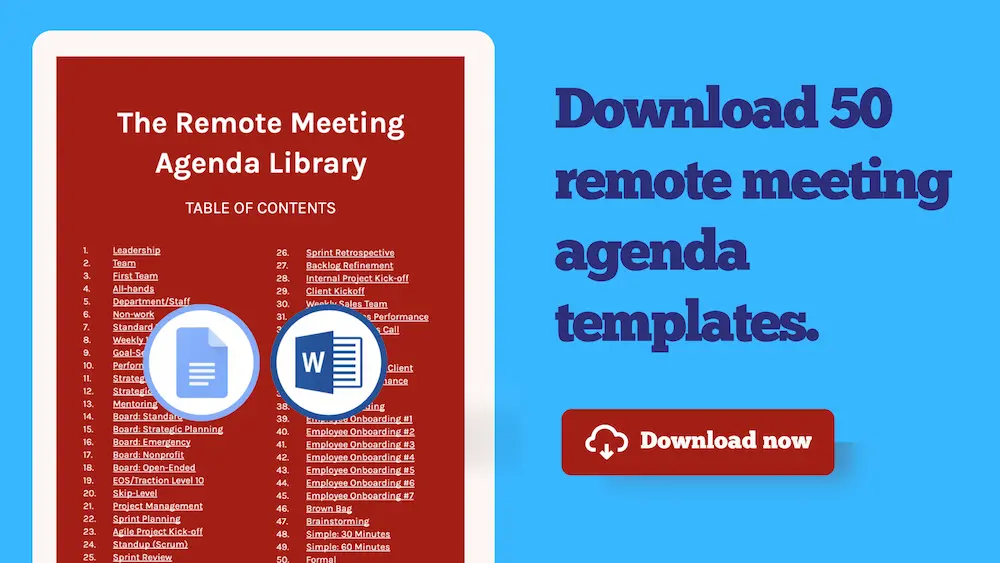6 Sprint Retrospective Templates

Access the free agenda in Docs | Download all 50 for $47
This is part of our series on meeting agenda templates. You can edit this sprint retrospective meeting agenda in Google Docs or Word or print it out.
Meeting Agenda Templates > Project Management Agendas > Sprint Retrospective Agenda
I implemented Agile/Scrum project management at a marketing agency in 2017 and ran the company that way until I left (to start Buildremote) in 2022. I ran probably close to 75 sprint retrospective meetings during that time.
The sprint retrospective agenda is straightforward. The purpose is to reflect on the past sprint so you can improve for future sprints. And the way you do that is to have structured discussions about good things, bad things, things to try, and things to change. There are several sprint retrospective templates you can use to surface those insights.
I cover six of them in this article – the go-to sprint retrospective agenda followed by five other ways to run the meeting.
Click one of the links below to jump to a section that interests you most:
- The main sprint retrospective agenda template
- 5 additional templates to try
- Who should attend?
- Sprint planning vs. review vs. retrospective
Sprint Retrospective Agenda Template
Purpose: To reflect on the past sprint (people, relationships, processes, and tools) so that you can improve for the next sprint.
- Frequency: At the end of each sprint (1, 2, or 4 weeks typically)
- Duration: 1 hour
Agenda:
- What went well last sprint? (15 minutes)
- Discuss things that should be continued
- What didn’t go well last sprint? (15 minutes)
- Discuss things that got in the way of success and why
- What did we learn last sprint? (15 minutes)
- Discuss ideas or process improvements that were discovered last sprint and should be maintained
- What should we do differently next sprint? (15 minutes)
- Discuss specific ways to change to clear roadblocks
- Record the exact tasks that need to be completed (and by whom)
Access the free agenda in Docs | Download all 50 for $47
5 More Sprint Retrospective Template Examples
In the agenda template above, you saw the most popular, simplest version of a sprint retrospective: what went well, what didn’t go well, what did we learn, what should we do differently?
But if that’s getting stale or it doesn’t fit with your needs, there are other ways to surface the right discussions in a sprint retrospective. Here are a few other sprint retrospective examples you could try.
Start, Stop, Continue
- Start: New practices or tools the team should adopt.
- Stop: Practices or behaviors that aren’t working and should be discontinued.
- Continue: Successful actions that should be maintained.
You can access a template and learn more here.
4 L’s (Liked, Learned, Lacked, Longed For)
- Liked: Elements of the sprint that team members felt positively about.
- Learned: New insights or skills the team acquired.
- Lacked: Resources or knowledge the team was missing.
- Longed For: Things the team wished had happened.
Atlassian has a good article on 4Ls retrospectives.
Mad, Sad, Glad
- Mad: Frustrations and problems encountered.
- Sad: Disappointing or discouraging aspects.
- Glad: Positive experiences and achievements.
You can read more about Mad, Sad, Glad in this great article.
KALM (Keep, Add, Less, More)
- Keep: Effective practices that should be continued.
- Add: New ideas or practices to implement.
- Less: Practices that should be reduced or modified.
- More: Successful actions that should be done more frequently.
Learn more about KALM in this article.
DAKI (Drop, Add, Keep, Improve)
- Drop: Things that no longer serve the team.
- Add: New ideas or practices to try.
- Keep: Practices that are working well and should be continued.
- Improve: Existing practices that need to be enhanced.
Read more about DAKI retrospectives here.
Who attends retrospective meetings?
This is who needs to be at your sprint planning meeting:
- Scrum Master
- Facilitator: The Scrum Master ensures that the meetings run smoothly and stays within the time limit.
- Scrum Coach: Acts as a coach to the team, helping members use the Scrum methodology correctly and efficiently.
- Roadblock Remover: Identifies obstacles that team members raise during the meeting and helps to turn them into tasks to fix said obstacles.
- Project Team Members
- All software developers or people who participate in the priorities of the sprint
- OPTIONAL: Product Owner
- Visionary: Represents the stakeholders (clients, management team, etc.) and the voice of the customer.
- Decision Maker: Makes strategic product decisions and prioritizes the backlog items, helping the team understand which tasks are most critical and why.
Similar Meeting Agendas
Click the links below to access another meeting agenda template.
View the complete meeting agenda template library
Download This (& More) Meeting Agendas
Want to download this meeting agenda in Google Docs or Word?
It’s part of our meeting agenda library that you can download here.




